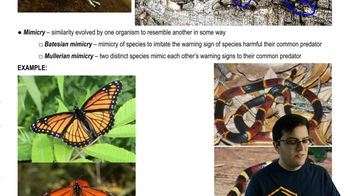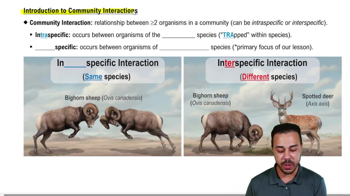Table of contents
- 1. Introduction to Biology2h 42m
- 2. Chemistry3h 40m
- 3. Water1h 26m
- 4. Biomolecules2h 23m
- 5. Cell Components2h 26m
- 6. The Membrane2h 31m
- 7. Energy and Metabolism2h 0m
- 8. Respiration2h 40m
- 9. Photosynthesis2h 49m
- 10. Cell Signaling59m
- 11. Cell Division2h 47m
- 12. Meiosis2h 0m
- 13. Mendelian Genetics4h 44m
- Introduction to Mendel's Experiments7m
- Genotype vs. Phenotype17m
- Punnett Squares13m
- Mendel's Experiments26m
- Mendel's Laws18m
- Monohybrid Crosses19m
- Test Crosses14m
- Dihybrid Crosses20m
- Punnett Square Probability26m
- Incomplete Dominance vs. Codominance20m
- Epistasis7m
- Non-Mendelian Genetics12m
- Pedigrees6m
- Autosomal Inheritance21m
- Sex-Linked Inheritance43m
- X-Inactivation9m
- 14. DNA Synthesis2h 27m
- 15. Gene Expression3h 20m
- 16. Regulation of Expression3h 31m
- Introduction to Regulation of Gene Expression13m
- Prokaryotic Gene Regulation via Operons27m
- The Lac Operon21m
- Glucose's Impact on Lac Operon25m
- The Trp Operon20m
- Review of the Lac Operon & Trp Operon11m
- Introduction to Eukaryotic Gene Regulation9m
- Eukaryotic Chromatin Modifications16m
- Eukaryotic Transcriptional Control22m
- Eukaryotic Post-Transcriptional Regulation28m
- Eukaryotic Post-Translational Regulation13m
- 17. Viruses37m
- 18. Biotechnology2h 58m
- 19. Genomics17m
- 20. Development1h 5m
- 21. Evolution3h 1m
- 22. Evolution of Populations3h 52m
- 23. Speciation1h 37m
- 24. History of Life on Earth2h 6m
- 25. Phylogeny2h 31m
- 26. Prokaryotes4h 59m
- 27. Protists1h 12m
- 28. Plants1h 22m
- 29. Fungi36m
- 30. Overview of Animals34m
- 31. Invertebrates1h 2m
- 32. Vertebrates50m
- 33. Plant Anatomy1h 3m
- 34. Vascular Plant Transport1h 2m
- 35. Soil37m
- 36. Plant Reproduction47m
- 37. Plant Sensation and Response1h 9m
- 38. Animal Form and Function1h 19m
- 39. Digestive System1h 10m
- 40. Circulatory System1h 57m
- 41. Immune System1h 12m
- 42. Osmoregulation and Excretion50m
- 43. Endocrine System1h 4m
- 44. Animal Reproduction1h 2m
- 45. Nervous System1h 55m
- 46. Sensory Systems46m
- 47. Muscle Systems23m
- 48. Ecology3h 11m
- Introduction to Ecology20m
- Biogeography14m
- Earth's Climate Patterns50m
- Introduction to Terrestrial Biomes10m
- Terrestrial Biomes: Near Equator13m
- Terrestrial Biomes: Temperate Regions10m
- Terrestrial Biomes: Northern Regions15m
- Introduction to Aquatic Biomes27m
- Freshwater Aquatic Biomes14m
- Marine Aquatic Biomes13m
- 49. Animal Behavior28m
- 50. Population Ecology3h 41m
- Introduction to Population Ecology28m
- Population Sampling Methods23m
- Life History12m
- Population Demography17m
- Factors Limiting Population Growth14m
- Introduction to Population Growth Models22m
- Linear Population Growth6m
- Exponential Population Growth29m
- Logistic Population Growth32m
- r/K Selection10m
- The Human Population22m
- 51. Community Ecology2h 46m
- Introduction to Community Ecology2m
- Introduction to Community Interactions9m
- Community Interactions: Competition (-/-)38m
- Community Interactions: Exploitation (+/-)23m
- Community Interactions: Mutualism (+/+) & Commensalism (+/0)9m
- Community Structure35m
- Community Dynamics26m
- Geographic Impact on Communities21m
- 52. Ecosystems2h 36m
- 53. Conservation Biology24m
51. Community Ecology
Introduction to Community Interactions
Problem 14c`
Textbook Question
The carnivorous plant Nepenthes bicalcarata ('fanged pitcher plant') has a unique relationship with a species of ant—Camponotus schmitzi ('diving ant'). The diving ants are not digested by the pitcher plants but instead live on the plants and consume nectar. Diving ants also dive into the digestive juices in the pitcher, swim to the bottom, and capture and consume trapped insects, leaving uneaten body parts and ant feces behind.
What nutritional impact do the ants have on fanged pitcher plants?
Do the pitcher plants derive any nutritional benefit from this relationship?
Explain why carnivorous and parasitic plants are most common in nutrient-poor habitats.
 Verified step by step guidance
Verified step by step guidance1
Understand the mutualistic relationship: The diving ants live on the Nepenthes bicalcarata and consume nectar, while the plant provides a habitat and food source for the ants.
Identify the nutritional contributions: The ants capture and consume trapped insects, leaving behind uneaten body parts and feces, which decompose and release nutrients that the plant can absorb.
Explain the benefit to the plant: The decomposition of insect remains and ant feces enriches the nutrient content of the pitcher fluid, providing essential nutrients like nitrogen and phosphorus to the plant.
Discuss the habitat context: Carnivorous and parasitic plants are common in nutrient-poor habitats because they have evolved mechanisms to obtain nutrients from alternative sources, such as insects or host plants, to compensate for the lack of nutrients in the soil.
Conclude the mutual benefit: The relationship between the fanged pitcher plant and diving ants is mutualistic, as the ants help increase the nutrient availability for the plant, while the plant provides food and shelter for the ants.
 Verified video answer for a similar problem:
Verified video answer for a similar problem:This video solution was recommended by our tutors as helpful for the problem above
Video duration:
3mPlay a video:
Was this helpful?
Key Concepts
Here are the essential concepts you must grasp in order to answer the question correctly.
Mutualistic Relationships
Mutualistic relationships involve two species benefiting from each other. In the case of Nepenthes bicalcarata and Camponotus schmitzi, the ants provide a cleaning service by removing prey remains, which may prevent decay and disease, while the plant offers nectar as a food source. This symbiosis can enhance the plant's nutrient acquisition indirectly through the ants' activities.
Recommended video:
Guided course

Fungi - 1
Carnivorous Plant Adaptations
Carnivorous plants have evolved mechanisms to trap and digest insects, compensating for nutrient-poor soil conditions. Nepenthes bicalcarata uses its pitcher structure to capture prey, relying on digestive juices to break down insects for nutrients. The presence of ants may aid in nutrient cycling by processing prey remains, potentially enhancing nutrient absorption for the plant.
Recommended video:

Adaptive Radiation
Nutrient-Poor Habitats
Carnivorous and parasitic plants are prevalent in nutrient-poor habitats because they have adapted to obtain essential nutrients from alternative sources, such as insects or host plants. These adaptations allow them to thrive where other plants might struggle due to limited availability of nitrogen and phosphorus, crucial for growth and development.
Recommended video:
Guided course

Soil Nutrients

 1:57m
1:57mWatch next
Master Introduction to Community Interactions with a bite sized video explanation from Jason
Start learningRelated Videos
Related Practice


















































